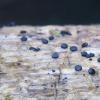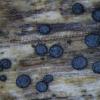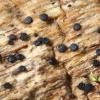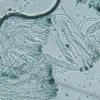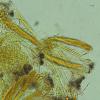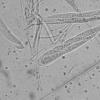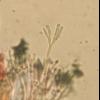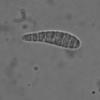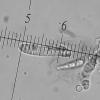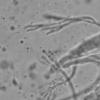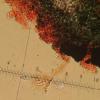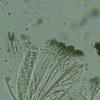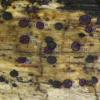
12-11-2025 09:25
 Viktorie Halasu
Viktorie Halasu
Hello, I need help with a pale terrestric Pseudom

11-11-2025 20:16
Bohan JiaHi, lastly I have found these tiny yellow decayin

09-11-2025 13:20
Hello.A tiny ascomycete, appearing as erupting gra

08-11-2025 00:29
 Francois Guay
Francois Guay
I found this species in Quebec, Canada, on herbace
Black discomycete with multiseptate spores
Stephen Martin Mifsud,
18-12-2021 11:04
 I found these tiny, flattened, sessile fruiting bodies 0.2-0.4 mm wide om bark of a decidous branch (Ficus carica if I remember well).
I found these tiny, flattened, sessile fruiting bodies 0.2-0.4 mm wide om bark of a decidous branch (Ficus carica if I remember well). - Paraphyes with black pigments, tips not particularly swollen, x2 -x4 branched, very beautiful.
- Asci 8-spored, J-ve, spores imbricated and tightly packed, 80-150 x 17-22 um wide (looking quite stout)
Spores 25-40um long, 6-10 septate, unsymetrically fusiform / irregular
Stephen Martin Mifsud,
18-12-2021 11:19

Re : Black discomycete with multiseptate spores
I think it is Cresponea ( a l ichen!)
Martin Bemmann,
18-12-2021 11:25

Re : Black discomycete with multiseptate spores
Hi Stephen,
this is Patellaria atrata to me (not lichenized).
Regards
Martin
Stephen Martin Mifsud,
18-12-2021 11:38

Re : Black discomycete with multiseptate spores
I thought those dull-green patches were bunches of algae, but seeing your suggestion, I agree more with it now.
https://fungi.myspecies.info/all-fungi/patellaria-atrata
Thank you.
https://fungi.myspecies.info/all-fungi/patellaria-atrata
Thank you.
Stephen Martin Mifsud,
18-12-2021 11:49

Re : Black discomycete with multiseptate spores
"the apices swollen to 3-5 µm diam and agglutinated, forming a greenish brown epithecium"
There we go ;-)
So those branched structures are called Interascal tissue (not paraphysis) ...
Thanks and I should have taken better pics, they are somewhat not in focus :-(
There we go ;-)
So those branched structures are called Interascal tissue (not paraphysis) ...
Thanks and I should have taken better pics, they are somewhat not in focus :-(
Guy Marson,
19-12-2021 14:43
Re : Black discomycete with multiseptate spores
Hi Stephen,
Martin is surely right, but the apothecia are unusual small for P. atrata. If you still got some fresh material, please show us some mic´s taken in tab water.
Cheers,
Guy
Martin is surely right, but the apothecia are unusual small for P. atrata. If you still got some fresh material, please show us some mic´s taken in tab water.
Cheers,
Guy
Stephen Martin Mifsud,
21-12-2021 15:16

Re : Black discomycete with multiseptate spores
Hi Guy, ok but tab water u mean tap water ? and when you wrote mic's you mean ? (new microscopy?) The ascocarps are still on the branch, does it make sense to culture them on media ?
tnx :-)
tnx :-)
Guy Marson,
21-12-2021 19:56
Re : Black discomycete with multiseptate spores
You´re right, tap water. With micro photos taken of fresh apothecia and water as medium, one can reliably see whether the genus Patellaria is right for such small apothecia.
In the last 6 years I had 5 collections from Patellaria atrata on Ficus carica (from southern France) with apothecia from 0.5 to 1.2mm in diameter.
P. atrata grows quite well in culture (on CMA 1:1).
In the last 6 years I had 5 collections from Patellaria atrata on Ficus carica (from southern France) with apothecia from 0.5 to 1.2mm in diameter.
P. atrata grows quite well in culture (on CMA 1:1).
Regards,
Guy
Stephen Martin Mifsud,
23-12-2021 07:37

Re : Black discomycete with multiseptate spores
Hello,
While going to dissect fresh specimens, I realized that in the previous measurments I must have used the wrong scale of measurement, and the actual measurments are within the range of P. atrata, although on the lower range. The largest one was 0.68 mm along the widest axis.
0.4 - 0.6 (0.7) × (0.3) 0.4 - 0.5 (0.6) µm
Q = (1) 1.1 - 1.3 (1.4) ; N = 15
V = 0 µm3
Me = 0.5 × 0.4 µm ; Qe = 1.2 ; Ve = 0 µm3
I read that apothecia are 0.3-1 mm diam so I t hink we are good.
Stephen Martin Mifsud,
02-01-2022 08:58

Re : Black discomycete with multiseptate spores
Is this correct - Patellaria atrata can live in marine environment ?
Martin Bemmann,
02-01-2022 12:28

Re : Black discomycete with multiseptate spores
According to this database:
P.a. seems to occur in mangrove forests on wood mostly not submerged by sea water.
Regards
Martin
Stephen Martin Mifsud,
03-01-2022 21:16

Re : Black discomycete with multiseptate spores
Strange !! Also, the site you cited is called : marinefungi.org. I find it very hard to associate this fungus with marine environment.
Martin Bemmann,
03-01-2022 22:08

Re : Black discomycete with multiseptate spores
I think that P.a. was found in a marine environment in a wider sense, qualified it to be listed in such databases.
We humans should also be listed as marine beeings, since we jump into the sea once and a while....
Stephen Martin Mifsud,
03-01-2022 22:54

Re : Black discomycete with multiseptate spores
LOL!!!
Thank for yr help once again
Thank for yr help once again

